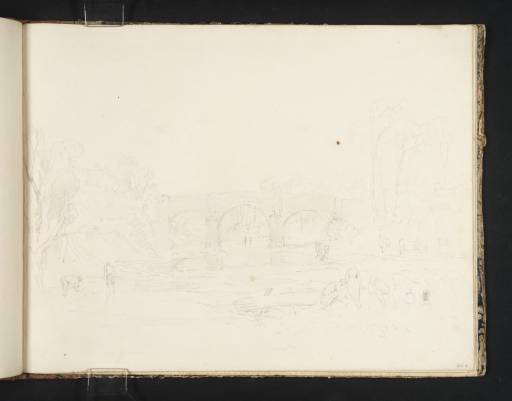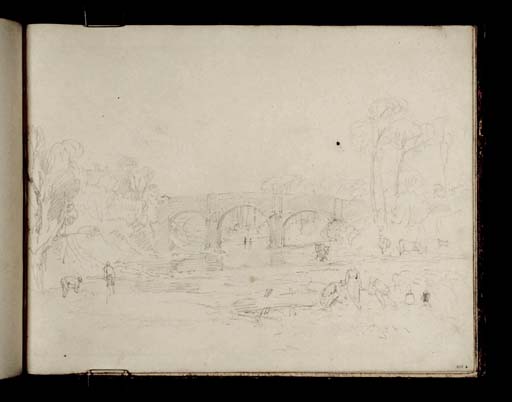Joseph Mallord William Turner The River Calder and Whalley Bridge 1808
Image 1 of 2
Joseph Mallord William Turner,
The River Calder and Whalley Bridge
1808
Joseph Mallord William Turner 1775–1851
Folio 18 Recto:
The River Calder and Whalley Bridge 1808
D06837
Turner Bequest CIII 8
Turner Bequest CIII 8
Pencil on off-white wove paper, 226 x 295 mm
Stamped in black ‘CIII 8’ bottom right
Stamped in black ‘CIII 8’ bottom right
Accepted by the nation as part of the Turner Bequest 1856
Exhibition history
1879
Oxford Loan Collection, University Galleries, Oxford, 1879 until at least 1909 (64–162b), as ‘Bridge, with Figures’.
References
1909
A.J. Finberg, A Complete Inventory of the Drawings of the Turner Bequest, London 1909, vol.I, p.271, CIII 8, as ‘Whalley Bridge’.
1910
A.J. Finberg, Turner’s Sketches and Drawings, London 1910, pp.62–3, reproduced pl.XXIX.
1967
Leslie Parris, The Loyd Collection of Paintings and Drawings at Betterton House, Lockinge near Wantage, Berkshire, London 1967, p.45.
1981
David Blayney Brown, Augustus Wall Callcott, exhibition catalogue, Tate Gallery, London 1981, pp.64, 65 note 7.
1984
Martin Butlin and Evelyn Joll, The Paintings of J.M.W. Turner, revised ed., New Haven and London 1984, p.84.
For Turner’s visit to Whalley in 1808 and his drawings of the bridge over the River Calder and the ruins of Whalley Abbey, see Introduction to the sketchbook.
This drawing became the basis for Whalley Bridge and Abbey, Lancashire: Dyers Washing and Drying Cloth (private collection)1 exhibited at the Royal Academy in 1811. In his 1910 book Finberg gives his own subjective interpretation of Turner’s supposed subjectivity in choosing this drawing rather than another in the sketchbook (folio 15, D06835; Turner Bequest CIII 6) as his model for the picture:
In the two drawings of Whalley Bridge ... we see him searching for that aspect of the place which shall fit in or harmonise with the mood which was predominant in his own mind at the time. It is only from the point of view of such a subjective emotional attitude that [D06835] could have been rejected in favour of the [present drawing]. As a representation of the actual place, the first drawing is much more adequate than the second. ... Here the interest is concentrated on a few simple forms. The mind is, therefore, thrown back on itself, and forced as it were to call up its own resources to amplify and fill out the painter’s forms. And this is the mood of poetic contemplation or meditation expressed in the beautiful picture...2
A suggestion by the present author that Whalley Bridge was commissioned by Thomas Lister Parker of Browsholme Hall was noted by Butlin and Joll, along with various factors supporting it. These include: the proximity of the subject to Browsholme; the likelihood that the drawings were made during a visit to Parker en route between Tabley House and Farnley Hall; Parker’s family connections with Sir John Leicester of Tabley and Walter Fawkes of Farnley; his antiquarian and architectural interests having advised Dr Thomas Dunham Whitaker on his History of Whalley published 1800–1 with illustrations after Turner; and the fact that the picture once belonged to John Newington Hughes who acquired another picture by Turner from Parker’s collection.3 Whitaker’s latest antiquarian book, The History of Craven, had been published in 1805 and although Turner made no illustrations specially for it, he did contribute an earlier drawing of Fountains Abbey for the second (1812) edition and may have considered making other new ones. Whalley was the springboard for his tour of the Craven Dales in 1808 and the similarity of subjects and viewpoints in later watercolours of Malham Cove, Bolton Abbey and Barden Towers bought by Fawkes to those in Samuel Alken’s aquatints to the 1805 edition of Craven has been noted.4 For a view of Malham Cove from this sketchbook see D06839; Turner Bequest CIII 10.
Verso:
Blank. Inscribed by John Ruskin in red ink ‘964’.
David Blayney Brown
May 2010
How to cite
David Blayney Brown, ‘The River Calder and Whalley Bridge 1808 by Joseph Mallord William Turner’, catalogue entry, May 2010, in David Blayney Brown (ed.), J.M.W. Turner: Sketchbooks, Drawings and Watercolours, Tate Research Publication, December 2012, https://www


